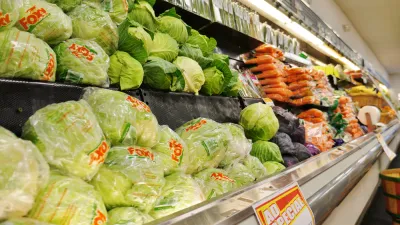According to one recent study, regional culture plays a major part in how healthily people eat. Supply may be less of a factor than demand.

Urbanist debates around healthy eating often focus on food deserts: places where healthy options aren't readily available. But according to this study, regional tastes and cultural preference may play a larger role.
As Caitlin Dewey puts it, "For years, advocates have argued that it's largely a problem of access: Consumers eat junk because they can't afford healthful foods or can't find them in their communities. Now, an emerging body of research suggests that some groups of consumers may simply be less interested than others in buying healthful groceries."
Lead author Hunt Allcott "hypothesizes that a region's dominant cuisine, be that barbecue or avocado toast, informs the meals that people eat as children. That, in turn, has a large effect on their lifelong food preferences."
The study calls out Montana's Musselshell County for its particularly unhealthful food purchases. Apparently, readers from Musselshell fired back, noting that "residents often supplement their diets with items from hunting trips and home gardens, meaning that they may be eating more healthfully than measurable data indicates."
FULL STORY: This is the U.S. county that buys the least healthful groceries

National Parks Layoffs Will Cause Communities to Lose Billions
Thousands of essential park workers were laid off this week, just before the busy spring break season.

Retro-silient?: America’s First “Eco-burb,” The Woodlands Turns 50
A master-planned community north of Houston offers lessons on green infrastructure and resilient design, but falls short of its founder’s lofty affordability and walkability goals.

Delivering for America Plan Will Downgrade Mail Service in at Least 49.5 Percent of Zip Codes
Republican and Democrat lawmakers criticize the plan for its disproportionate negative impact on rural communities.

Test News Post 1
This is a summary

Test News Headline 46
Test for the image on the front page.

Balancing Bombs and Butterflies: How the National Guard Protects a Rare Species
The National Guard at Fort Indiantown Gap uses GIS technology and land management strategies to balance military training with conservation efforts, ensuring the survival of the rare eastern regal fritillary butterfly.
Urban Design for Planners 1: Software Tools
This six-course series explores essential urban design concepts using open source software and equips planners with the tools they need to participate fully in the urban design process.
Planning for Universal Design
Learn the tools for implementing Universal Design in planning regulations.
EMC Planning Group, Inc.
Planetizen
Planetizen
Mpact (formerly Rail~Volution)
Great Falls Development Authority, Inc.
HUDs Office of Policy Development and Research
NYU Wagner Graduate School of Public Service



























